Table of Contents
Magnetic Properties of Materials:
All substances whether solid, liquid or gaseous show certain reaction to magnetic fields. On the basis of the reactions shown by them, the substances have been classified under three headings- diamagnetic, paramagnetic and ferromagnetic substances. The general behaviour of these substances in the magnetic fields are briefly described below-
Diamagnetic Substances:
Diamagnetic substances are those substances that are repelled by a magnet. Example- Bismuth, antimony, copper, mercury, zinc, lead, water, air etc. are diamagnetic substances.
Properties of Diamagnetic Substances:
- When a diamagnetic substance is suspended in a uniform magnetic field, they set their longest axis at right angles to the direction of the field, i.e., the shortest axis is along the direction of the field.

- When a diamagnetic substance is placed in a non-uniform magnetic field, it tends to move from the stronger to the weaker regions of the magnetic field. When a diamagnetic liquid contained in a watch glass is placed on two pole-pieces lying close to each other, it shows a depression in the middle and gets accumulated at the sides as shown in the figure. This is because the magnetic field is stronger in the middle and weaker at the sides. However, when the pole pieces are sufficiently apart as shown in fig, the magnetic field is weaker in the middle and stronger at the sides. The liquid now accumulates in the middle and shows depression at the sides.

- Take some diamagnetic liquid in a U-shape tube. Apply, magnetic field to one limb of the tube. The liquid in that limb is depressed.
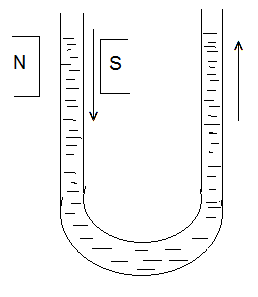
- When a diamagnetic substance is placed in a magnetic field, the lines of force does not pass through a diamagnetic substance. Hence the permeability (μ) of diamagnetic substance is always less than one but never negative.
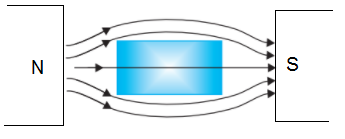
- We know, μ = 1 + 4πxm where xm is the susceptibility of a magnetic substance. In the case of diamagnetic substance, permeability (μ) is less than 1. It implies that (xm) susceptibility of diamagnetic substance is always negative.
- The susceptibility of diamagnetics does not change with temperature. Bismuth at low temperature is an exception to this general property.
- Diamagnetic substances can be compared to non polar type dielectrics.
Paramagnetic Substances:
Paramagnetic substances are those substances that are attracted by a magnet but very feebly. Aluminium, chromium, oxygen, platinum, manganese, alkali and alkaline earth metals are examples of paramagnetic substances.
Properties of Paramagnetic Substances:
- In a uniform magnetic field, a paramagnetic substance rotates until its longest axis is parallel to the field.
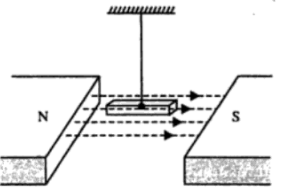
- In a non-uniform magnetic field, a paramagnetic substance moves from the weaker to the stronger part of the field.
- Take some paramagnetic liquid in a U-shape tube. Apply, magnetic field to one limb of the tube. The liquid in that limb is raised.
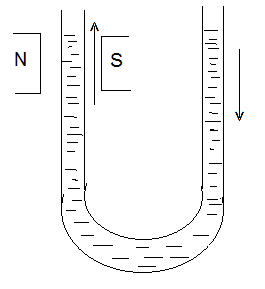
- When a paramagnetic substance is placed in a magnetic field, the lines of force does pass through the paramagnetic substance. Hence, the permeability (μ) of a paramagnetic substance is always greater than one.
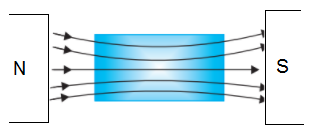
- We know, μ = 1 + 4πxm where xm is the susceptibility of a magnetic substance. In the case of paramagnetic substance, susceptibility is always positive.
- Susceptibility of paramagnetic substance varies inversely as the temperature of the substance i.e.
| xm ∝ 1/t |
- Paramagnetic substances can be compared to polar dielectrics.
Ferromagnetic Substances:
A substance is said to be ferromagnetic if it is attracted strongly by a magnet and aligns itself in the direction of the applied magnetic field. Iron, cobalt, nickel and their alloys are ferromagnetic.
Properties of Ferromagnetic Substances:
- When a ferromagnetic substance is placed in a magnetic field, the magnetic lines of force tend to crowd into the specimen as shown in the figure.

- When a ferromagnetic substance is placed in a non-uniform magnetic field, it moves from weaker to stronger parts of the magnetic field. Let us consider the behaviour of a ferromagnetic liquid contained in a watch glass and placed on two closely placed magnetic pole pieces. It would be observed that the ferromagnetic liquid flows from the sides (weaker magnetic field) to the middle (stronger magnetic field). Thus, there will be an accumulation of ferromagnetic liquid in the middle as shown in the figure. If the pole pieces are moved farther apart, the liquid will be observed to be depressed in the middle and accumulated at the sides as shown in the figure. This is because the magnetic field will become weaker in the middle and stronger at the sides.

- When a ferromagnetic substance is freely suspended in a uniform magnetic field, it aligns itself parallel to the direction of the magnetic field as shown in the figure.
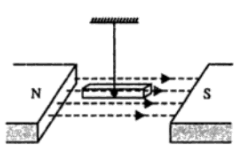
- When a ferromagnetic substance is placed in a magnetic field, it develops strong induced magnetism. So, the ferromagnetic substance is strongly attracted by a magnet.
- A ferromagnetic substance is strongly magnetized by even a weak magnetic field and the flux density inside the material increases several hundred or thousands times the original value. The relative permeability (μr), for a ferromagnetic material, is very large and magnetic susceptibility (xm) is positive.
- The permeability (μr) and susceptibility (xm) vary with the temperature in a complicated way. At high enough temperature Tc a ferromagnetic material behaves as a paramagnetic and then (i.e., above temperature Tc) the magnetic susceptibility xm is given by-
| xm = C / T-Tc , (T > Tc) Where Tc is called as curie’s temperature. |
- Ferromagnetic materials show the phenomenon of magnetic hysteresis.









Comments (No)